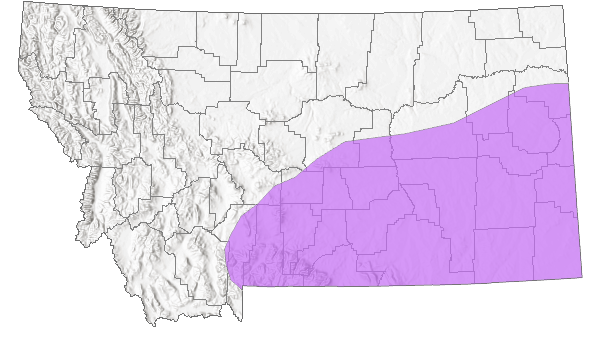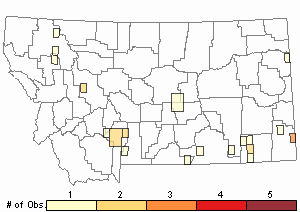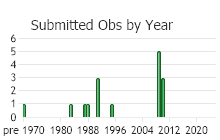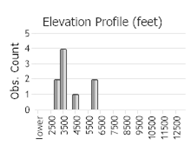View in other NatureServe Network Field Guides
NatureServe
Montana
Utah
Wyoming
Idaho
Wisconsin
British Columbia
South Carolina
Yukon
California
New York
Virginia Wildrye - Elymus virginicus
Native Species
Global Rank:
G5
State Rank:
S3S4
(see State Rank Reason below)
C-value:
4
Agency Status
USFWS:
USFS:
BLM:
External Links
State Rank Reason (see State Rank above)
Elymus virginicus primarily occurs in south-central and southeast Montana with a few records from the northwest and northeast areas of the state. The MTNHP follows the revised draft treatment in the Manual of Montana Vascular Plants which lumps Elymus curvatus, Elymus submuticus, and Elymus virginicus var. submuticus under Elymus virginicus. Known locations are scattered, despite that plants grow in fairly common habitats. Population data is lacking, and threats have not been identified. Surveys that bring forth information on current locations, populations sizes, ecology, and/or threats are needed.
- Details on Status Ranking and Review
Range Extent
ScoreG - 200,000-2,500,000 sq km (~80,000-1,000,000 sq mi)
Comment220,840 square kilometers for 38 observations.
Area of Occupancy
ScoreE - 26-125 4-km2 grid cells
CommentMontana can be divided into 30,390 4x4 square kilometer cells. For this species plant observations occur in 28 of these 4x4 square kilometer cells.
Number of Populations
ScoreC - 21 - 80
Comment37 observations: 13 (1888-1967), 24 (1973-2010)
Environmental Specificity
ScoreD - Broad. Generalist or community with all key requirements common
General Description
PLANTS: Bunchgrass. Stems are 80–130 cm tall. Sources: Barkworth et al. in Flora of North America [FNA] 2007; Lesica et al. 2012.
LEAVES: Blades are 5–12 mm wide, flat, and spreading or lax. Leaf sheaths are usually glabrous, rarely hirsute. Ligules are less than 1 mm long. Auricles are absent. Sources: Barkworth et al. in FNA 2007; Lesica et al. 2012.
INFLORESCENCE: A terminal bilateral spike with more than one spikelet per node, 6-12 cm long. The rachis is continuous and erect. Spikelets are usually 2 per node, 10–13 mm long, and disarticulate below the glumes. Glumes are distinctly broadest in the lower half and taper to a short awn or awn-tip. Glumes have 3 to 5 veins, a yellowish base (1 mm) that is distinctly indurate (bony), round in cross-section, and outwardly curving. Lemmas are mostly 2 to 4 per spikelet, essentially hairless, 6-9 mm long, and bear a straight awn of 10–20 mm long. Sources: Barkworth et al. in FNA 2007; Lesica et al. 2012.
Phenology
Pollen is typically released (anthesis) around mid-June to late July, sometimes mid-August (Barkworth et al. in FNA 2007).
Diagnostic Characteristics
For
Elymus virginicus the MTNHP follows the treatment used in the draft revised
Manual of Montana Vascular Plants, which lumps
Elymus curvatus,
Elymus submuticus, and
Elymus virginicus var. submuticus together because short-awned plants do not always align with differences in leaf morphology for Montana specimens and anthesis is seldom known or could vary across distributions (Lesica et al. 2012). However, any observation submitted under the name
Elymus curvatus will be tracked in our database by that name.
Virginia Wildrye -
Elymus virginicus, native
*Lemma awns are 5-15 (20) mm long. All leaf blades are flat,
and spreading or lax. Lower leaves are not noticeably larger or more persistent than upper leaves. Anthesis occurs from mid-June to mid-August or 1-2 weeks earlier than
Elymus curvatus. Compare these characteristics with
Elymus curvatus.
*Spikelets are 10-13 mm long. Basal 1-2 mm of glume is bony (shatters from the seed-head), yellowish, and outwardly curved. Grows in regularly disturbed sites that are not in the mountains. Compare these characteristics with
Elymus glaucus.
Awnless Wildrye -
Elymus curvatus, native
*Lemma awns are 0.5-3(4) mm long. Upper leaves usually ascend and are somewhat involute. Lower leaves are relatively shorter, narrower, and senesce earlier than upper leaves. Anthesis occurs from late June to early August or 1-2 weeks later than
Elymus virginicus. Compare these characteristics with
Elymus virginicus.
Blue Wildrye -
Elymus glaucus, native
*Spikelets are 12-20 mm long. Basal 1-2 mm of glume is not bony, mostly greenish, and not outwardly curved. Grows in undisturbed dry meadows and open understories in the mountains. Compare these characteristics with
Elymus virginicus.
Species Range
Montana Range
Range Descriptions

 Native
Native
Range Comments
Across southern Canada and over most of the eastern two-thirds of the U.S. (Lesica et al. 2012).
Observations in Montana Natural Heritage Program Database
Number of Observations: 26
(Click on the following maps and charts to see full sized version)
Map Help and Descriptions
Relative Density

Recency



 (Observations spanning multiple months or years are excluded from time charts)
(Observations spanning multiple months or years are excluded from time charts)
Habitat
Shady moist understory settings at lower elevations (Lesica et al. 2012).
Stewardship Responsibility
References
- Literature Cited AboveLegend:
 View Online Publication
View Online Publication Lesica, P., M.T. Lavin, and P.F. Stickney. 2012. Manual of Montana Vascular Plants. Fort Worth, TX: BRIT Press. viii + 771 p.
Lesica, P., M.T. Lavin, and P.F. Stickney. 2012. Manual of Montana Vascular Plants. Fort Worth, TX: BRIT Press. viii + 771 p.
- Additional ReferencesLegend:
 View Online Publication
View Online Publication
Do you know of a citation we're missing? Boggs, K. W. 1984. Succession in riparian communities of the lower Yellowstone River, Montana. M.S. Thesis. Montana State University, Bozeman, 107 pp.
Boggs, K. W. 1984. Succession in riparian communities of the lower Yellowstone River, Montana. M.S. Thesis. Montana State University, Bozeman, 107 pp. Brey, C.W. 1998. Epidemiology of wheat curl mite (Aceria tosichella K.) and wheat streak mosaic virus on feral grass species and effect of glyphosate on wheat curl mite dispersal. Ph.D. Dissertation. Bozeman, MT: Montana State University. 136 p.
Brey, C.W. 1998. Epidemiology of wheat curl mite (Aceria tosichella K.) and wheat streak mosaic virus on feral grass species and effect of glyphosate on wheat curl mite dispersal. Ph.D. Dissertation. Bozeman, MT: Montana State University. 136 p. Carroll, M.W. 1998. Influence of a legume covercrop on volunteer wheat, the wheat curl mite, Aceria tosichella (K.) and wheat streak mosaic virus. M.Sc. Thesis. Bozeman, MT: Montana State University. 78 p.
Carroll, M.W. 1998. Influence of a legume covercrop on volunteer wheat, the wheat curl mite, Aceria tosichella (K.) and wheat streak mosaic virus. M.Sc. Thesis. Bozeman, MT: Montana State University. 78 p. Eversman, S.T. 1968. A comparison of plant communities and substrates of avalanche and non-avalanche areas in south central Montana. M.Sc. Thesis. Bozeman, MT: Montana State University. 39 pp.
Eversman, S.T. 1968. A comparison of plant communities and substrates of avalanche and non-avalanche areas in south central Montana. M.Sc. Thesis. Bozeman, MT: Montana State University. 39 pp. Lesica, P., M.T. Lavin, and P.F. Stickney. 2022. Manual of Montana Vascular Plants, Second Edition. Fort Worth, TX: BRIT Press. viii + 779 p.
Lesica, P., M.T. Lavin, and P.F. Stickney. 2022. Manual of Montana Vascular Plants, Second Edition. Fort Worth, TX: BRIT Press. viii + 779 p.
- Web Search Engines for Articles on "Virginia Wildrye"





